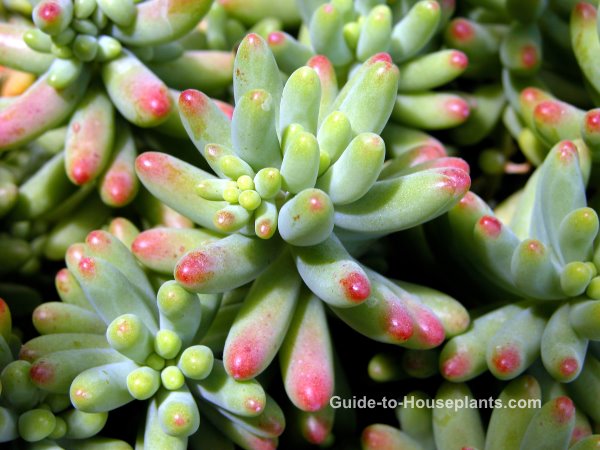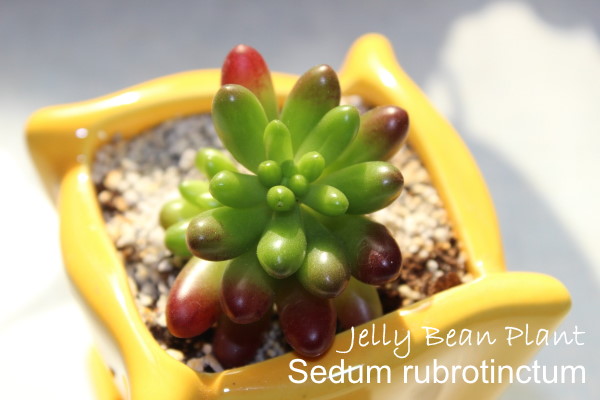Grow Sedum Rubrotinctum Indoors
Botanical Name: Sedum rubrotinctum
Many plants in the Sedum family make good houseplants. Because of its easy-growing nature and good looks, S. rubrotinctum is one of the most popular of this clan to come indoors.
 Plump, rounded leaves give this popular succulent the common name Jelly Bean Plant.
Plump, rounded leaves give this popular succulent the common name Jelly Bean Plant.Get to Know Sedum Rubrotinctum as a Houseplant
Sedum rubrotinctum is native to Mexico, where it lives with year-round warm temperatures and lots of sunshine. Give it the same treatment, and you'll find this succulent easy to live with indoors.
How big does it get? Your houseplant will reach a height up to 8 in (20 cm).
Jelly Bean makes a beautiful, colorful addition to a succulent dish garden. Although it looks pretty good on its own, too. Stems will eventually grow long enough to trail over the side of the container, so you can display your plant in a hanging basket if you want.
In spring, you can expect Sedum rubrotinctum to bloom with bright-yellow, star-shaped flowers. No blooms? Your plant may still be too young or not getting enough sunlight.
Did you know...
Sedums are rock lovers? Sedum comes from the Latin sedo, meaning "I sit" because many of the species appear to grow on rocks in their native habitat. Sedum's rock-loving nature gives this group the common name Stonecrop.
The Sedum genus belongs to the Crassulaceae plant family and includes about 500 species, most of them flowering succulents.
Let it bask in the sun. Move your plant outdoors for the summer, if you want. This good-natured succulent can take the heat. Those bright green leaves will even get more beautiful, turning red at the tips after sun exposure.
Repot in spring, only when your plant gets too crowded. Handle this plant carefully -- those leaves may fall off at the slightest touch. But don't toss them out... you can propagate the leaves for more plants. Just poke the cut end into moist potting medium and they'll root easily.
Dropped leaves? Jelly Bean Plant will drop its leaves if it is either over-watered or under-watered. Use a pot with drainage holes so you can water thoroughly without drowning the plant. If you want to cover up a plain nursery pot, just slip it into a cachepot -- a decorative container without drainage holes. See "Water" tips below.

Sedum rubrotinctum is easy to find in garden centers, plant shops and online. You may find it listed with common names Jelly Bean Plant or Pork and Beans. One new cultivar that's getting attention is 'Aurora' which has pink-tinged leaves instead of red.
Sedum Rubrotinctum Care Tips
Light: This hardy succulent thrives in bright, indirect light to full sunlight. Don't have a sunny window? Use a grow light. If you move your plant outdoors for the summer, make the move a gradual one; indoor-grown plants can sunburn easily.
Water: Water thoroughly throughout the growing season, allowing the potting medium to dry out between waterings. Water sparingly in winter when growth is slow. It's better to err on the dry side -- this desert succulent is more tolerant of dry potting medium than wet.
Humidity: Average room (around 40% relative humidity) or lower. This desert native prefers dry air.
Temperature: Average to warm room temperatures (65-80°F/18-27°C). If you move your plant outdoors for the warm months, don't worry -- it can take the heat. Bring it back indoors when nighttime temps drop to 50°F/10°C.
Soil: Sandy, fast-draining medium, such as cactus potting mix.
Fertilizer: Jelly Bean is not a heavy feeder. As with watering, don't over-do it. Feed every other month during spring and summer with a liquid or water-soluble fertilizer specially made for succulents, diluted by half.
Propagation: Easy to grow from stems or leaves. Allow the stem or leaf to dry for about a day, so it doesn't ooze sap. Poke a short stem or a leaf into lightly moist potting medium and S. rubrotinctum will readily grow roots in about 3-4 weeks. Keep the plant out of direct sun until it shows new growth.


